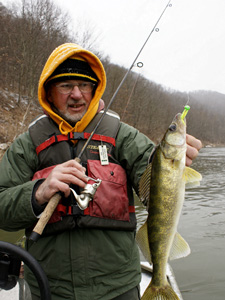
 January typically signals a hiatus in my guide trips, a break that lasts a couple of months. But it doesn't signal an end to my fishing. Winter fishing for river walleyes can warm up a cold day.
January typically signals a hiatus in my guide trips, a break that lasts a couple of months. But it doesn't signal an end to my fishing. Winter fishing for river walleyes can warm up a cold day.
I'm fortunate to live within a few minutes of the Pool 6 section of the lower Allegheny River in western Pennsylvania; during breaks in the weather, it's often a practical matter to drop the boat in the icy water for a couple hours of sport.
Boat launching during the winter can be a touchy endeavor. Here's a few of the precautions I suggest to ensure safe launching and retrieving of the boat this time of year:
- Carry a snow shovel to clear any buildup of snow off the ramp. Try to pick ramps that have only a moderate pitch; ones exposed to the southern sun tend to be more ice free this time of year also.
- Carry a supply of traction material. A bag of rock salt will quickly melt away a thin layer of ice providing the temperature if not too much below freezing. Ground clay, like kitty litter or the stuff used in repair shops to absorb spilled oil, when lightly spread over packed snow/ice will provide a lot of bite for tires.
- If a thin sheet of shore ice has developed off the end of the ramp, it can usually be broken with the spud end of a post hole digging bar. Don't try breaking it by backing out with the trailer. While you might break the ice, you'll likely crush your trailer lights (yes, I've learned this the hard way). Also, a curb of ice often forms at the end of the ramp, where the payment meets the water. The bar can be used to knock the high spots off this curb, so the trailer frame doesn't saddle bag on it.
- Don't attempt launching without a four-wheel-drive vehicle with good tires.
- Be sure to always wear a personal flotation device such as one from Bass Pro Shop's XPS series. Inflatable devices, while effective and convenient during warm/cool weather fishing, can't be trusted in sub-freezing temperatures.
- 5451 views

